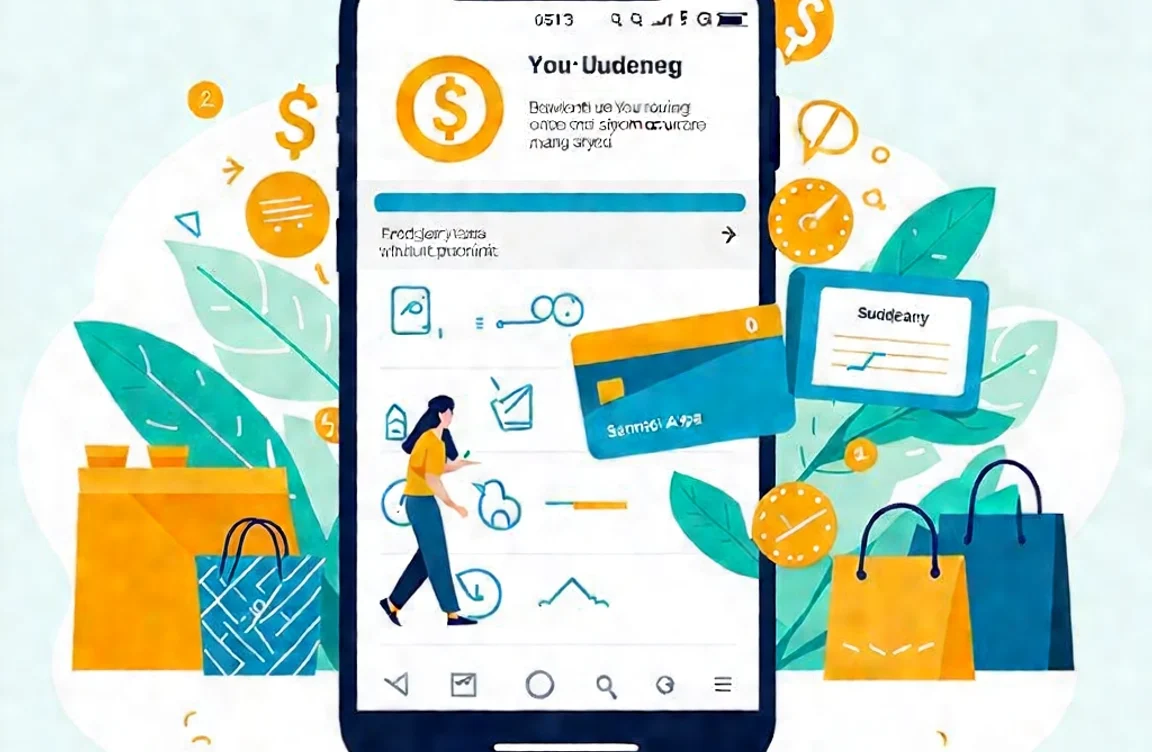
How To Elevate Your Financial Wellness
Learn how to elevate your financial fitness, effortlessly manage your money, save for the future, and achieve your financial goals with innovative technology.
Financial Fitness: From Splurge to Savvy
Why We Splurge, Sink into Debt, and Smart Ways Out! Learn about financial fitness and why shopping sprees are too tempting. Understand how swiping the card too often digs us into a money pit. This blog breaks down what financial fitness is, the shopping triggers, and the credit card trap. It also provides the ultimate guide to spending wisely and ditching debt. It also has the best tools to manage your cash like a pro
The Concept of Credit Cards in Buying and Debt
Credit cards have revolutionized the way we think about money. They offer a convenient way to make purchases, big or small, without the immediate need to pay up. However, this convenience comes with a hidden trap: the illusion of unlimited spending power. An example that highlights this issue is the ease with which one can swipe a card for a large purchase. This is compared to the psychological barrier of handing over an equivalent amount of cash. This disconnect can lead to accumulating debt. Young people might not fully grasp the long-term implications of their credit card spending.

The Influence of Technology on Buying
Technology, particularly smartphones and e-commerce platforms, has made buying an almost reflexive action. With just a few taps, you can deliver anything from groceries to gadgets to your doorstep. An example is the rise of “buy now, pay later” apps, which promise convenience but often encourage overspending. The instant gratification of making a purchase contrasts sharply with the delayed pain of payment. This dissonance can easily lead to debt.
The Influence of Color in Buying
Colors play a significant role in consumer behavior. They influence how we perceive products and make purchase decisions. Red, for example, is often used in sale signs and advertisements to create a sense of urgency, encouraging quick purchases. This subtle manipulation can lead to impulsive buying. Shoppers are drawn to the excitement of a deal, sometimes disregarding their actual needs or financial plans.
The Influence of Advertising on Debt
Advertisements are designed to sell not just products but lifestyles. They often portray an idealized world where happiness is just a purchase away. An example of this is the promotion of high-end electronics or designer clothing by celebrities and influencers. This creates a perceived need among young people to spend beyond their means to emulate these lifestyles. This can contribute to accumulating debt as individuals strive to live up to these advertised ideals.
Avoiding Impulse Buying and Debt
Impulse buying is a common pitfall that can lead to unnecessary debt. One effective strategy to avoid this is the creation of a 30-day list. Before making any non-essential purchase, add the item to a list and wait 30 days. If, after this period, the desire for the item persists and it fits within your budget, consider purchasing it. This cooling-off period allows for more thoughtful spending decisions. It can significantly reduce impulse buys and, consequently, debt.
Spiritual Angle to Debt
Debt is not just a financial issue; it has moral and spiritual dimensions as well. Many religious teachings caution against the accumulation of debt, viewing it as a burden that can enslave the debtor. An example is the Christian teaching that equates debt to a form of slavery, where one is bound to the lender. This perspective encourages a more conscientious approach to spending and debt. It advocates living within one’s means and avoiding unnecessary financial obligations.
Top Apps for Personal Finance Management
In the digital age, numerous tools and apps are available to help manage finances, budget effectively and avoid debt.
United States
Mint offers a comprehensive overview of your financial picture. It includes bank accounts, credit cards, bills, investments, and credit scores. It helps track spending, create budgets, and even provides personalized tips for reducing fees and saving money.
You Need a Budget (YNAB): YNAB focuses on giving every dollar a job, ensuring you’re making deliberate choices with your spending. It’s great for individuals looking to get serious about their budgeting practices.
Canada
PocketGuard helps Canadians manage their money. It shows how much they must spend. This is after accounting for bills, goals, and savings. It’s beneficial for avoiding overspending
Moka: Moka rounds up every purchase you make to the nearest dollar and invests the spare change. It’s an effortless way to start investing without feeling the pinch on your daily finances.
Australia
Frollo, a free money management app, empowers users to take control of their finances by increasing savings and reducing debt. Utilize Open Banking for secure account linking and enjoy features like expense breakdowns and goal setting
Raiz, formerly known as Acorns in Australia, invests your spare change from daily purchases into a varied portfolio. This makes it easy to start investing with an exceedingly small amount.
India
Axio, formerly Walnut, analyzes your SMS inbox to track spending. It manages bills in one place. It’s particularly useful in India, where many transactions still generate SMS notifications.
ETMoney offers many financial features. These include expense tracking, investments, loans, and insurance. It’s a one-stop shop for personal finance management in India.
Nigeria
PiggyVest stands as a prominent personal finance app in Nigeria, providing automated savings, investment options, and flexible withdrawals. Its intuitive interface streamlines saving for short and long-term goals effectively.
Carbon (formerly PayLater) is not just a tool for personal finance and budgeting. It also gives instant loans and investment options. This makes it a versatile app for managing finances in Nigeria.
United Kingdom
Emma: This app connects all bank accounts, credit cards, investments, and savings, providing a complete picture of your finances. Emma uses analytics to identify opportunities for saving money, including identifying wasteful subscriptions and suggesting better deals. Its user-friendly interface and proactive budgeting tools make it an excellent choice for those looking to manage their money more effectively.
Plum: Plum is a finance-savvy chatbot that automates savings, monitors bills, and even invests money for you. It analyzes your transactions to learn about your income and spending. Based on this, Plum sets aside an amount that won’t be missed, helping you save effortlessly.
South Africa
22seven: Developed by Old Mutual, 22seven is a smart app that helps South Africans manage their money more effectively. It securely links to bank accounts and provides a detailed analysis of spending habits. Users can create budgets, track their investments, and receive personalized financial advice, making 22seven a pivotal tool for financial wellness in South Africa.
Stash by Liberty: This app makes saving and investing simple. Stash rounds up transactions to the nearest rand and stashes the change in an investment account. It’s a fuss-free way to start investing in top South African companies without feeling the pinch.
China
Alipay goes beyond just a digital wallet; it’s an essential part of daily life for millions in China. It offers a plethora of services from payments to wealth management and even includes budgeting tools. With its user-friendly interface, Alipay makes managing personal finances a breeze for its users, offering insights into spending patterns and savings opportunities.
WeChat Pay: While known primarily as a messaging app, WeChat Pay features robust financial tools. Users can make payments, transfer, and manage their finances within the app. Its integration into daily life makes financial management seamless for its users.
Mexico
Fintonic operates on the principle of putting users in control of their finances. It aggregates information from various bank accounts and credit cards to provide a clear view of one’s financial status. With features like expenditure categorization, budget setting, and alerts for fees and duplicate charges, Fintonic is empowering Mexicans to make more informed financial decisions.
Clip: Though primarily a payment solution for businesses, Clip also offers features that benefit individual users, such as easy tracking of expenditures and management of personal finance through seamless transactions.
Brazil
GuiaBolso is a leading financial management app in Brazil, offering users a real-time overview of their financial situation by connecting directly to their bank accounts. It provides automatic categorization of expenses, budgeting tools, and personalized financial tips. GuiaBolso plays a crucial role in helping Brazilians improve their financial health by simplifying financial planning.
Nubank: As one of the leading digital banks in Latin America, Nubank simplifies banking with a no-fee checking account, a high-yield savings option, and a credit card. The app is designed to give users total control over their finances with real-time notifications and comprehensive
How These Apps Help
Budgeting apps help you see where your money goes. You set budgets based on your income and expenses. Then, you adjust your spending habits.
Tracking Spending: It tracks your purchases and bills in real time. This helps you find areas where you might overspend.
Savings & Investments: Some apps can save or invest your spare change. This makes it easier to grow your wealth.
Debt Management tools monitor your debts. They provide strategies for paying them down well. They can help you reduce and eventually eliminate debt.
Unique Examples
In the US, Mint can send alerts about unusual charges to help prevent fraud.
In Canada, Moka’s round-up feature effortlessly builds investment capital.
India’s Axio uses SMS tracking. This feature fits the Indian market. It relies on SMS for transaction notifications.
In Nigeria, Carbon offers loans. They provide a cushion for unexpected expenses and reduce the need for high-interest credit.
To use these apps well, you must commit to regularly checking your finances. You must adjust budgets as needed and stay disciplined about your goals. You may want to manage daily costs, save for future goals, or invest. There’s a tool out there to help guide your financial journey.
Final Words
Understanding the psychology of buying is crucial for financial well-being. The same is true for knowing the risks of debt, especially for young people. Recognizing technology, color, and advertising helps. Avoiding impulse buying also helps. Both let individuals navigate modern consumerism more wisely. Tools and resources can support financial management. Considering debt’s spiritual and moral implications can also motivate responsible spending. Informed choices and careful spending are the keys. They help you avoid debt and achieve security.
